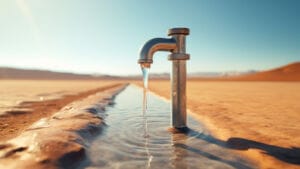
After 16 years of drought on the Colorado River, how is it Arizona is not in a water crisis? We are not in a crisis due to a legacy of leadership and sound, future-thinking water planning. The Central Arizona Project (CAP) and its partners are continuing this leadership with a steadfast focus on tomorrow’s challenges.
Before the existence of the CAP, Arizona could only make use of less than half of its Colorado River entitlement. This stifled economic development led to dramatic groundwater overdraft, with water users pumping groundwater at a rate unsustainable by natural recharge.
With construction of the CAP came a renewable supply of surface water to meet the needs of municipalities, agricultural users and Indian tribes. That water has been the engine for approximately $100 billion in economic activity per year, accounting for one-third, and in recent years close to one-half, of the entire Arizona gross state product. To protect the economic vitality of Arizona, CAP and the Arizona Water Banking Authority have also stored 3.4 million acre-feet of water (MAF) underground, on which the state may rely in future years when supplies from the Colorado River may be curtailed.
The citizens of Arizona have done their part, as water consumption in the state remains at the level in was in 1957, while the population has grown by five times.
That Arizona is not in a crisis after enduring 16 years of drought demonstrates how the state’s plans, and actions of the CAP and its stakeholders, have successfully protected the state’s most vital resource.
Despite this success, CAP has long understood that the Colorado River is over allocated and cannot be sustained at current usage levels. Additional action is required, and Arizona and CAP are actively participating in creating solutions focused on protecting water levels in Lake Mead and finding long-term solutions to the problem.
In December 2014, CAP, the Arizona Department of Water Resources, the federal government and entities from California and Nevada entered into an agreement to conserve up to 740,000 acre-feet in Lake Mead by the end of 2017. The agreement has reduced the near-term risk of Lake Mead falling below critical elevations that could trigger shortage being declared by the Secretary of the Interior.
In addition, CAP and the federal government, Denver Water and agencies from California and Nevada are funding a pilot conservation program to conserve Colorado River water for the benefit of all users. This new approach protects the river and all who depend on it. CAP and its partners look to expand these programs in the coming years.
Even with these programs, and planned cuts to Arizona and Nevada in the event of a shortage declaration, projections show water levels in Lake Mead may continue to drop. More action is necessary, and CAP continues to work with its partners in Arizona and on the Colorado River to protect the interests of Arizona in preserving the Colorado River.
While Arizona is not in a water crisis today, we are facing serious challenges going forward. You can be assured Central Arizona Project and its partners are focused on these challenges to protect and secure Arizona’s current and future water supplies.




